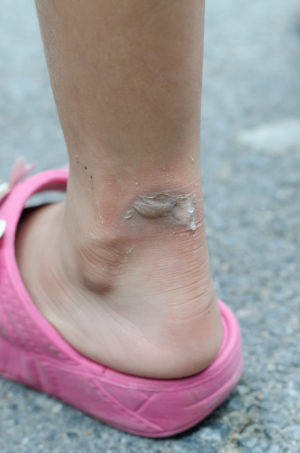 Ulcers are open sores or lesions on your body that are slow to heal. They occur as the result of skin tissue breakdown, and they are usually accompanied by pain and discomfort. Below, we take a closer look at why ulcers can develop on your ankle and how the condition is treated.
Ulcers are open sores or lesions on your body that are slow to heal. They occur as the result of skin tissue breakdown, and they are usually accompanied by pain and discomfort. Below, we take a closer look at why ulcers can develop on your ankle and how the condition is treated.
Causes and Symptoms of Ankle Ulcers
Before we get into the the causes of ankle ulcers, we have to explain the three common types of ulcers. There are:
- Venous Stasis ulcers
- Diabetic ulcers
- Arterial ulcers
Venous statis ulcers are the more common type of ulcer in the lower body, especially in the ankles. They account for between 80 and 90 percent of ulcers on the lower legs. These types of ulcers are typically caused by hypertension or poor blood flow to the ankles. When blood doesn’t flow well to your ankles, pressure can build up in your veins, and this pressure can lead to ulceration of the skin. Typically, this forms on the inside of your legs, just above your ankles.
Symptoms of ankle ulcers include:
- Pain
- Discomfort
- A burning or itching sensation
- Skin discoloration
- Swelling
- Discharge when infected
Diagnosing and Treating Ankle Ulcers
Diagnosing an ankle or foot ulcer is pretty straightforward. Your doctor will take a look at your health history and ask about your symptoms. They’ll then conduct a physical exam to take a look at the suspected ulcer. Depending on how long you’ve had the ulcer, they may also collect a tissue sample to ensure it is non-cancerous. They’ll also check to see if there is an infection. After looking at all these aspects of your condition, your doctor will be able to diagnose your ulcer and set you up with a treatment plan.
Preventing swelling and increasing blood flow to the ulcer helps with the healing process, so it should come as no surprise that compression treatment is one of the most recommended treatment options. Options like compression wraps, compression stockings and medications can all help to treat minor to mild ankle ulcers. Your doctor will also walk you through proper wound care procedures, which may include special dressings, infection preventing creams and how often to change the dressing. Keeping the ulcer clean will help to encourage healing as well.
Other lifestyle adjustments that can help ankle ulcers heal include drinking plenty of fluids, getting regular exercise and rest, and eating a healthy diet. By working on aspects of your life that can encourage healthy blood flow and decrease fluid buildup and pressure in your legs, you can help to treat and prevent ankle ulcers.
For more information, or if you want help treating an ankle issue that you’re dealing with, reach out to Dr. Silverman’s office today.